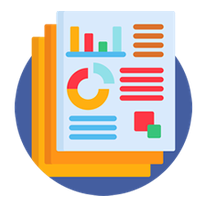Key Features:
No of pages:108
Abstract:
This research project is designed to bring out the importance of audit to the effective working of the organization using First Bank Nigeria Plc Okpara Avenue,Enugu State. In pursuant to this, data were collected by personal interview, questionnaires and through researcher’s observation. Secondary data were collected from journals, publications and related works. Also, findings showed that all the strategies for effective working operations are applicable in the case study. It was revealed that because of the laws guiding auditors, the attitude and perception of auditors to effective working operation inmy case study was adequate.Finally, based on these findings, various recommendations were made amongstwhich include, that for auditor’s work to be relied upon by other or for the work ofauditors not to be subjected to any loss or damage, they should not accept gifts orpackages, have personal relationship with clients and should carry out their dutiesin compliance with statutory requirements.
Table of Content:
TABLE OF CONTENTSTITLE PAGE ICERTIFICATION IIDEDICATION IIIACKNOWLEDGEMENT IVABSTRACT VLIST OF TABLES VITABLE OF CONTENTS VIICHAPTER ONE1.0 INTRODUCTION 11.1 BACKGROUND OF STUDY 1-21.2 HISTORY OF CASE STUDY 2-61.3 STATEMENT OF THE PROBLEM 61.4 OBJECTIVES OF STUDY 61.5 STATEMENT OF HYPOTHESIS 71.6 SIGNIFICANCE OF THE STUDY 8-91.7 SCOPE AND DELIMITATION OF THE STUDY 81.8 DEFINITION OF SOME RELEVANT TERMS 9REFERENCES 11
CHAPTER TWO
2.0 LITERATURE REVIEW 12
2.1 HISTORICAL BACKGROUND OF AUDITING 12-13
2.2 GENERAL AUDITING 12-14
2.3 DEFINITION OF AUDIT 14-15
2.4 TYPES OF AUDIT 15-16
2.5 WHO IS AN AUDITOR 16
2.6 THE GENERAL VIEW OF AUDITING 16-19
2.7 AUDITING THEORY 19
2.8 IMPORTANCE OF AUDITING TO THE COMPANY. 19-20
2.9 APPOINTMENT OF AUDITORS 20-21
2.9.1 REMUNERATION OF AUDITORS 22
2.9.2 REMOVAL OF AUDITORS 22-24
2.9.3 ENGAGEMENT LETTER 24
2.9.4 PURPOSE OF ENGAGEMENT LETTER 24
2.9.5 PRINCIPAL CONTENTS OF ENGAGEMENT LETTER 25
2.9.6 DUTIES AND RIGHTS OF AUDITORS 25-27
2.9.7 RIGHTS OF AUDITORS 27-28
2.9.8 RESIGNATION OF AUDITORS 28-29
2.9.9 SECTION 360 FURTHER PROVIDES THAT 29-30
2.10 AUDITORS LIABILITY 30-33
2.11 IMPLICATIONS OF THE LAW ON AUDITORS 33
2.11.1 POSITIVE IMPLICATIONS 33
2.11.2 NEGATIVE IMPLICATIONS 33-34
2.12 ACCOUNTING RECORDS 34
2.13 RESEASONABLE STANDARD OF CARE AND SKILL IN CARRYING OUT HIS DUTIES 35-36
2.14 THE ROLE OF AUDITORS INA CORPORATE ORGANISATION 36-37
2.15 WAYS IN WHICH THE LIABILITIES OF AUDITORS CAN BE LIMITED 37-40
2.16 ICAN RULES TO GUARANTEE INDEPENDENCE OF AUDITORS 41-42
2.17 CAMA 1990 TO GUARANTEE INDEPENDENCE 422.18 INVESTIGATIONS 42
2.18.1 STAGES AND PROCEDURES OF AN INVESTIGATION 43-49
2.19 ACCOUNTING AND AUDITING STANDARDS 49-50
2.19.1ACCOUNTING STANDARD 502.19.2 THE RELEVANCE OF ACCOUNTING STANDARDS TO AUDITING 50
2.19.3 ADVANTAGES OF ACCOUNTING STANDARD 512.19.4 DISADVANTAGE OF ACCOUNTING STANDARD 51
2.20 AUDITING STANDARD AND GUIDELINES 52
2.20.1 STATEMENT OF AUDITING STANDARDS 52-53
REFERENCES 54
CHAPTER THREE
3.0 RESEARCH DESIGN AND METHODOLOGY 55
3.1 INTRODUCTION 563.2 SOURCESOFDATA 56
3.2.1 PRIMARY SOURCES OF DATA COLLECTION 56
3.2.2 SECONDARY SOURCES OF DATA COLLECTION 57
3.3 THE POPULATION OF STUDY 57
3.4 SAMPLE SIZE AND SAMPLING TECHNIQUE 58
3.4.1 SAMPLE SIZE 58
3.4.2 SAMPLE TECHNIQUE 58
3.5 METHODS OF DATA COLLECTION 59
3.6 PROCEDURES FOR PROCESSING COLLECTED DATA 59
CHAPTER FOUR
4.0 PRESENTATION AND ANALYSIS OF DATA 604.1 A BRIEF INTRODUCTION OF THE CHAPTER 60
4.2 GROUP RETURNS, RESPONDENTS, CHARACTERISTICS AND CLASSIFICATION. 60#
4.3 PRESENTATION AND ANALYSIS OF RESEARCH QUESTIONS 61-66
4.4 TEST OF HYPOTHESIS 66-68
REFERENCES 69
CHAPTER FIVE
5.0 SUMMARY, CONCLUSION, AND RECOMMENDATION 70
5.1 SUMMARY 70
5.2 CONCLUSION 70-71
Buy Now
